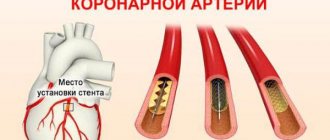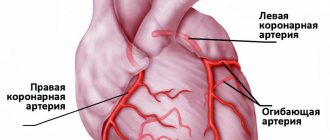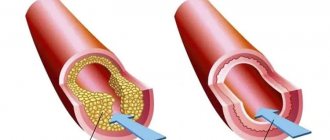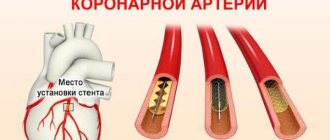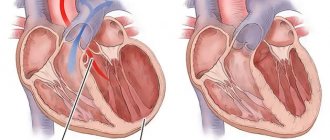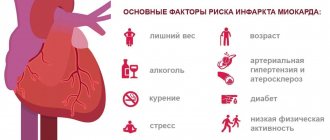Myocardial infarction is always a great risk to a person’s life. The cause of almost every third death in our country is cardiac arrest due to insufficient blood supply (ischemia) to the heart muscle (myocardium), as a result of which the organ tissue begins to die. Up to 40% of people with this diagnosis die in the first 15-20 minutes after the onset of the disease. That is why it is so important for patients with pathologies of the cardiovascular system to undergo examinations, to know the first signs of the development of myocardial infarction in women and men, and to always be ready to call an ambulance. Your health and life, as well as the lives of your loved ones, next to whom you find yourself at the right moment, may depend on the ability to correctly identify the symptoms of the disease, competent and prompt actions.
Symptoms of myocardial infarction at different stages of the disease
Signs of myocardial infarction differ at different stages of pathology development. During the disease there are 4 stages:
- stage of ischemia or acute period;
- stage of necrosis (acute period);
- stage of organization or subacute period;
- post-infarction period (scarring stage).
About 40% of all recorded heart attacks come as a surprise to the patient. Most often, doctors explain these by people’s inattention to their health. In the remaining 60% of cases, the disease is preceded for a long time by angina attacks.
The first signal to show concern is the appearance of pain in the chest, back, left shoulder or forearm, sometimes radiating to the jaw, ear and, less often, to the stomach and lower back. The nature of the pain varies: from mild and sluggish to acute and cutting. Typically, such pain appears after playing sports or during everyday physical activity, during emotional experiences and stress. These are the first signs of coronary heart disease. In nine out of ten cases, IHD develops due to vascular atherosclerosis (deposits of cholesterol in the inner walls of blood vessels) that supply blood to the heart muscle.
Such attacks can be observed in a patient from several weeks to two, three or more years and often, if not intervened, end in myocardial infarction. Have you noticed these in yours? Contact specialists immediately! Timely measures taken, diagnosis and observation by doctors will help avoid the development of the disease.
If coronary heart disease is not treated, then the next stage may be the most acute period of a heart attack.
conclusions
More than 15% of cases of heart attack at a young age develop as a result of hormonal disorders, changes in blood clotting, congenital pathology of the heart and blood vessels. In addition to atherosclerosis, the risk of a heart attack increases the risk of an unhealthy lifestyle, alcohol and smoking abuse, and excess weight. Often, a heart attack at the age of 35–45 years occurs with atypical symptoms, which complicates diagnosis and can lead to death if it is delayed to see a doctor. When the first alarming symptoms appear, you should call an ambulance. If a heart attack is confirmed, delivery to the hospital within 2–6 hours will allow stenting, minimizing the risk of consequences and preventing a dangerous outcome.
Remember the following signs and symptoms of myocardial infarction:
- The first symptom of myocardial infarction is acute, squeezing or pressing pain in the chest, radiating to adjacent organs, the left ear, jaw, left arm, and sometimes the upper abdomen. The pain can last from half an hour to a day and, unlike angina, is not relieved by taking nitroglycerin;
- patients with the first signs of a heart attack may complain of toothache;
- the painful condition is accompanied by chills, weakness and dizziness, sometimes shortness of breath and cold sweat;
- arrhythmia develops, the pulse increases noticeably;
- the skin becomes pale gray due to lack of blood supply.
The nature and severity of pain during a heart attack depend on the location of the muscle damage. The larger it is, the stronger the pain. Sometimes the only symptom of a heart attack is sudden cardiac arrest.
The acute period is one of the most dangerous stages of the disease. Some of the cardiac muscle tissue is already dead, and the heart, finding itself in unusual conditions, may not withstand the load and stop. If you feel such symptoms and make sure that the usual remedies for angina pectoris do not help, immediately call an ambulance.
Symptoms during the acute stage of myocardial infarction become less pronounced. The pain subsides. As a result of tissue necrosis, the patient's temperature rises, which, depending on the focus of necrosis, may not subside for up to 7-10 days.
In the subacute period, the signs of myocardial infarction disappear, heartbeat and body temperature normalize. A week or two after a heart attack, the dead portion of the heart muscle begins to scar.
In the post-infarction period, there are no symptoms of the disease. But angina attacks will not simply disappear, so if measures are not taken, there is a high probability of developing a recurrent myocardial infarction. To avoid this, it is necessary to treat the root causes of the pathology: coronary disease and atherosclerosis. Due to damage to blood vessels by cholesterol plaques, not only the heart suffers, but also the limbs, digestive organs and brain (cerebral infarction).
Complications
Complications of a heart attack are associated with damage to areas of the heart, conduction tracts, and thrombosis of the cavities of the heart. The development of a heart attack means the death of one or another structural element of the heart.
- Arrhythmias
Approximately 90% of patients experience some form of heart rhythm disturbance (arrhythmia) during or immediately after the event. In 25% of patients, rhythm disturbances appear within the first 24 hours. In this group of patients, the risk of serious arrhythmias, such as ventricular fibrillation, is greatest during the first hour and then gradually decreases. The physician must correctly evaluate these arrhythmias, since some of them can lead to cardiac arrest, so constant ECG monitoring is necessary in patients with myocardial ischemia.
- Damage to the myocardium and heart structure.
Death of heart tissue due to interruption of blood supply can lead to the breakdown of this tissue and damage to the structure of the heart. Most often, there are 3 main mechanical complications of a heart attack:
- Spontaneous rupture of the ventricular wall.
- A rupture of the interventricular septum means that a disturbance of intracardiac blood flow and hemodynamics develops.
- Severance of the papillary muscle is a rupture with the subsequent development of severe mitral valve insufficiency.
- Post-infarction aneurysms of the left ventricle.
A left ventricular aneurysm is a localized area of the myocardium with abnormal protrusion and deformation during systole and diastole, which appears due to the replacement of the myocardium with scar tissue. An aneurysm is dangerous due to the accumulation of thrombotic masses in its lumen, followed by embolism (transfer) through the bloodstream to other organs. With an aneurysm, the volume of the left ventricle increases, which means its relative functional insufficiency manifests itself.
- Thrombotic complications
During a heart attack, a parietal thrombus often occurs in the left ventricle; it develops especially often after heart attacks that occurred in the area of the anterior wall of the left ventricle. The frequency of this complication during a heart attack is 20-60%, which leads to a high risk of a blood clot breaking off and transferring through the bloodstream (embolism). Anticoagulant therapy can significantly reduce the risk of thrombosis and embolism.
Symptoms and signs of myocardial infarction in women
Female heart attacks have a number of atypical features and are less studied compared to male ones. The thing is that women are less likely to suffer from coronary heart disease. They are helped in this by estrogen, a hormone that is produced by the female body almost throughout life. It prevents the development of atherosclerosis. After menopause, the amount of estrogen in the body decreases and the chances of developing coronary heart disease in women increase.
Precursors of myocardial infarction in women are often swelling of the extremities that appear at the end of the day, chronic fatigue, shortness of breath, and digestive problems.
Often, a heart attack in women occurs without severe chest pain and may be accompanied by nausea, high fever and high blood pressure. Sometimes a false toothache develops. There are also cases of asymptomatic heart attacks.
This course of the disease is much more dangerous, since the patient can endure the first signs of the disease without attaching much importance to them. Some patients who have experienced a heart attack find out about it only after a while, undergoing diagnostics.
Treatment
Assistance for microinfarction should be provided only in the cardiology department of the hospital. The task of my colleagues is to relieve pain, localize the focus of necrosis and take measures so that the heart can function as before.
The following groups of drugs are used for treatment:
- anticoagulants;
- neuroleptanalgesia or narcotic analgesics;
- polarizing mixture, droppers with a solution of glucose and salts;
- beta blockers;
- antiarrhythmic drugs;
- prolonged nitrates.
The patient is advised to follow bed rest and a diet excluding salt and fatty foods. After discharge, physical, mental and social rehabilitation is desirable. If the patient’s professional activity is associated with constant overload, he is sent to a commission for transfer to easier work.
Symptoms and signs of myocardial infarction in men
In men, the course of the disease has all the characteristic signs:
- sharp pain behind the sternum, in the left arm, shoulder and forearm;
- sticky cold sweat;
- weakness, dizziness, pale gray skin color;
- shortness of breath, rapid pulse;
- high blood pressure.
Despite the development of medicine, acute myocardial infarction is increasingly being diagnosed in both men and women under 40 years of age. The reason for this is a sedentary lifestyle; a diet with a predominance of unhealthy fats, which are rich in fast food products; obesity; smoking; diabetes. Young patients often have an asymptomatic form of heart attack.
Measures to prevent cardiovascular pathology
To avoid developing heart disease, you need to stop smoking and reduce your alcohol consumption.
Severe stress is also one of the predisposing factors to the occurrence of IHD. It is impossible to remove stress from life, but you can react to it correctly: humans are evolutionarily designed in such a way that muscle work is necessary after any stress. If you are worried or upset, then you need to squat, jog, or walk – the muscles should get tired. In case of severe anxiety, you may need to use sedatives, for the selection of which you need to consult a doctor.
Regular exercise with moderate physical activity is useful for the prevention of ischemia. You also need to monitor your weight and blood pressure. All persons over 40 years of age must be examined annually - take a biochemical blood test to check the level of cholesterol in the blood, and do an ECG.
Author:
Baktyshev Alexey Ilyich, General Practitioner (family doctor), Ultrasound Doctor, Chief Physician
Signs of atypical myocardial infarction in women and men
Atypical signs of the disease are observed in elderly patients who have experienced one or more myocardial infarctions. Based on the nature of the symptoms, several atypical forms are distinguished:
- the abdominal form is characterized by indigestion, nausea, vomiting, hiccups;
- in the asthmatic form, the patient feels suffocated and may develop a cough;
- the cerebral form is represented by dizziness, presyncope;
- atypical pain syndrome (toothache, pain in the neck, left ear, spine, left leg, left fingers).
Often, acute myocardial infarction occurs without signs or symptoms in both women and men and is detected only after a while, after the patient has done an ECG. A silent heart attack is typical for patients with diabetes mellitus because it dulls the pain syndrome. This course of the disease is much more dangerous: the absence of symptoms of myocardial infarction makes it difficult to provide first aid to the patient. The only way to avoid the development of coronary heart disease and prevent myocardial infarction is to undergo timely and regular diagnostics of the cardiovascular system. At the Center for Circulatory Pathology, our specialists work with the latest equipment from Europe, the USA and Asia, which is capable of diagnosing the disease long before the first signs and symptoms of myocardial infarction. Treatment in our center is based on the best experience of domestic and foreign medical practices.
For patients whose health does not allow them to come to our Center, there is a special on-site diagnostics department. Based on a special method of non-surgical treatment of cardiovascular diseases, we develop a unique set of therapy and diagnostics for everyone who comes to our clinic.
Causes of pre-infarction condition
The condition of pre-infarction is caused by a cessation of nutrition to the heart muscle due to blockage or spasm of blood vessels. Older women are most often affected by the following factors:
- hypertonic disease;
- IHD;
- diabetes;
- atherosclerosis;
- nervous fatigue;
- frequent stress;
- excessive physical activity;
- body hypothermia;
- bad habits: smoking, alcohol;
- excess weight.
Advertising:
The pre-infarction state can last for days or even weeks. It manifests itself in the form of squeezing pain or burning. Urgent measures are needed to normalize blood circulation in order to prevent the onset of the next phase of the disease - a heart attack.
The state of the cardiac system directly reflects the health of the body. Deviation of at least one of the indicators of its work (rhythm, tension, frequency of contractions) indicates an imbalance. Read more in the article: “normal heartbeat in women, what it is like.”

